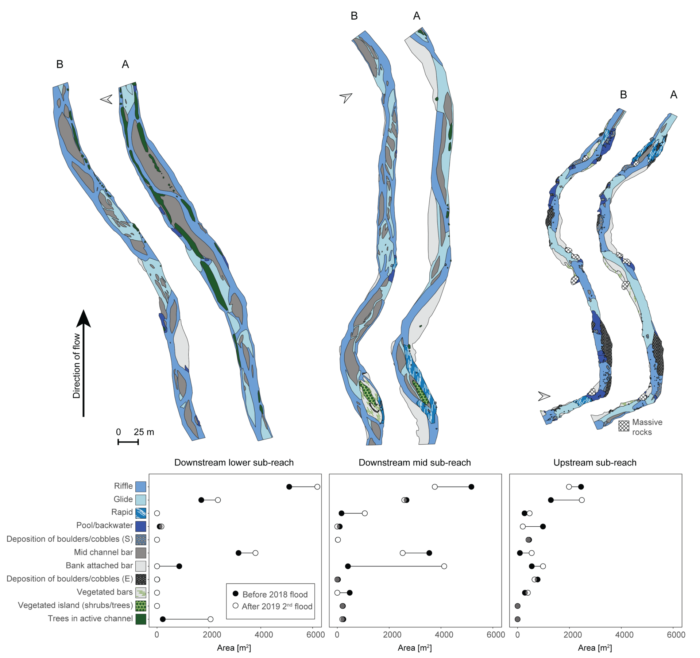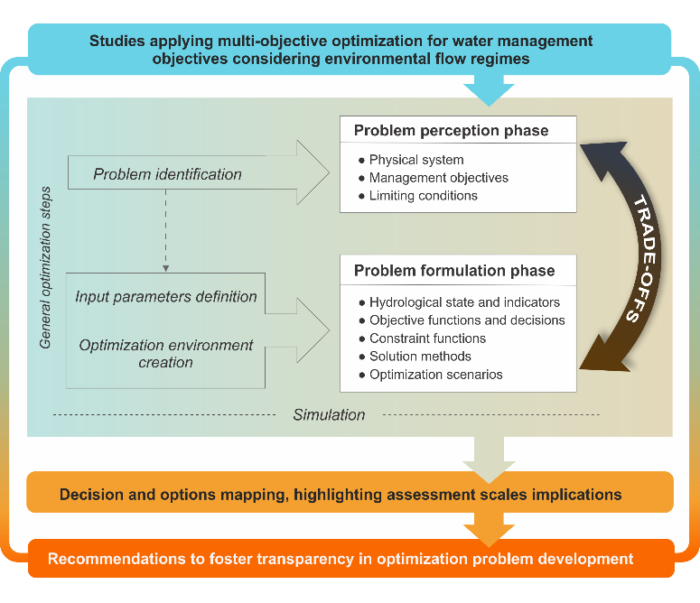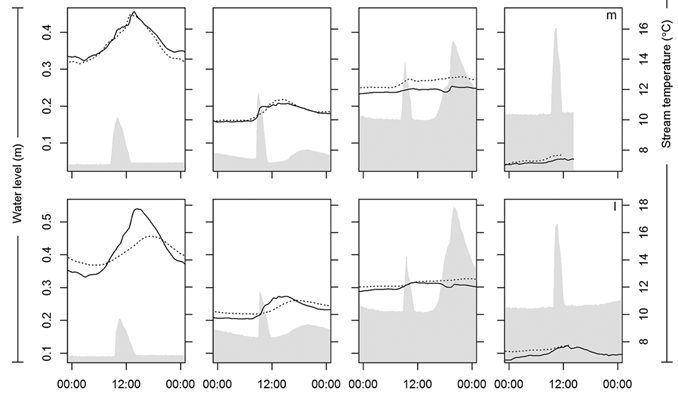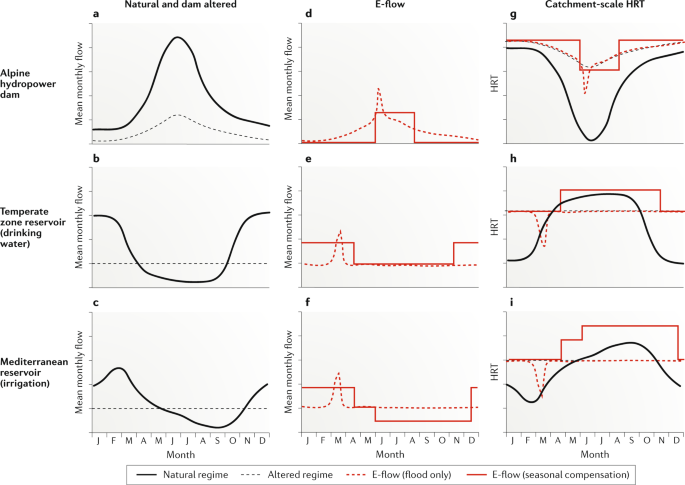Outputs
1. Published articles by Early Career Researchers
Gabriel Consoli and Saman Hashemi
Tributary effects on the ecological responses of a regulated river to experimental floods, Journal of Environmental Management, Volume 303, 2022.
The focus of the paper is how a tributary (source of sediment and water) influences eco-morphological responses of a river to experimental floods. Our main findings highlight the importance of tributaries in restoring ecosystem properties lost after damming, enhancing the resilience of the system. In addition, we observed that disturbance legacy played a fundamental role in determining ecological conditions of a river prior to experimental floods, thus confirming that considering flow variability and sediment availability is crucial in adaptive dam management and environmental flows design. This work is partly based on the data collected during the summer school in Zernez.

Above: Figure 7. Geomorphic units and sub-units assemblage of the three sub-reaches before 2018 flood (B) and after 2nd 2019 flood (A) (for sub-reach location along the study reach see Fig. 1S in supplementary material). The lower panel shows changes in geomorphic units and sub-units areas across the same period. (S) = partly submerged, (E) = emerged.
Devanshi Pathak (CEH)
Devanshi has her PhD work published in Water Resources Research, title: Hourly Prediction of Phytoplankton Biomass and its Environmental Controls in Lowland Rivers. We have developed a high-resolution river model to predict hourly-scale dynamics of phytoplankton biomass and relevant physico-chemical water quality variables in lowland rivers. The model was tested in the lower River Thames, UK, using hourly to monthly scale observations of a two year period. Through this modelling exercise, we demonstrated that the model satisfactorily predicts the diurnal variability and transport of phytoplankton biomass along the river network, and can serve as a powerful tool both for predictive purposes and for hindcasting past conditions when hourly resolution water quality monitoring was unavailable. We also derived important environmental controls and their optimum ranges that promoted high phytoplankton blooms, and suggested possible management solutions for phytoplankton management in the river. Overall, the hourly model improves biomass prediction and represents a step forward in high‐resolution phytoplankton modelling and consequently, bloom management in lowland river systems.
Also a new paper in 2022:
Pathak, D., Hutchins, M., Brown, L.E., Loewenthal, M., Scarlett, P., Armstrong, L., Nicholls, D., Bowes, M., Edwards, F., Old, G. (2022). High-resolution water-quality and ecosystem-metabolism modelling in lowland rivers. Limnology and Oceanography.
Diana Derepasko (UFZ)
Diana's first PhD paper is a review paper on optimization problem decisions and their implications for the spatial and temporal scales that featured a collaboration with Joseph Guillaume (Australian National University) and Avril Horne (Melbourne University), title: Considering scale within optimization procedures for water management decisions: balancing environmental flows and human needs. Here is the graphical abstract:

Her second paper is cited as follows: Derepasko, D.; Peñas, F.J.; Barquín, J.; Volk, M. Applying Optimization to Support Adaptive Water Management of Rivers. Water 2021, 13, 1281.
Lorenzo Pin (NIVA)
Lorenzo has a new publication in Molecular Ecology Resources journal, entitled Two different approaches of microbial community structure characterization in riverine epilithic biofilms under multiple stressors conditions: Developing molecular indicators, which reports on a significant correlation between the prokaryotic community composition and pH in rivers from two different geographical areas in Norway. CARD‐FISH and metabarcoding data followed the pattern of the environmental variables, but the main feature distinguishing the community composition was the regional difference itself.
Afua Owusu (IHE)
Afua published a paper based on the literature review of her PhD work, entitled Re‐operating dams for environmental flows: From recommendation to practice which covers practical cases of dams being re-operated to release environmental flows. Afua presented it at the 6th Biennial Symposium of the International Society for River Science which was held at the University of Natural Resources and Life Sciences (BOKU) in Vienna, Austria in September 2019. The article is part of a special issue of the conference contributions in the River Research and Applications Journal on the theme of Riverine landscapes as coupled socio-ecological systems.
In November 2021 - Afua also had two new accepted papers:
The first paper is titled ‘May the odds be in your favour: Why many attempts to re-operate dams for the environment stall’ in the Journal for Water Resources Planning and Management. In this paper we explore the impasse narrative on e-flows implementation through dam re-operation. We thank all EuroFlow colleagues for their contribution to this paper which used the responses to the survey we sent out in November 2019. The DOI for the paper (10.1061/(ASCE)WR.1943-5452.0001521) will be activated when the paper is published online in the ASCE Library.
The second paper is titled ‘The clam and the dam: A Bayesian belief network approach to environmental flow assessment in a data scarce region’ in Science of the Total Environment journal. This paper was written in collaboration with Martin and Michael of UFZ during my secondment. In the paper we demonstrate an ecologically grounded, parsimonious method for designing e-flows in a data scarce region.
2. Published articles by Supervisors and Partners.
Limited impacts of experimental flow releases on water quality and macroinvertebrate community composition in an upland regulated river
Ben Gillespie (project partner Yorkshire Water) and Lee Brown (Leeds) show that the introduction of short-term flow pulses in flashy regulated river systems in the English Pennines is unlikely to yield significant changes in water quality and biota. Using a field study that manipulated compensation flows from reservoirs in the Pennine uplands of northern England, changes in water quality and benthic macroinvertebrates were measured. Results showed minor short-term changes in water quality, but no evidence of immediate (within 48 hr) responses by the macroinvertebrate community to individual flow releases. However, a shift in macroinvertebrate community composition was found after multiple releases suggesting a potential role for cumulative rather than single environmental flow events.

River dam impacts on biogeochemical cycling
Lee Brown contributed to this review of river regulation effects on biogeochemistry, in particular leading the sections on environmental flows from knowledge developed in Euro-FLOW. The paper discusses how damming changes nutrient biogeochemistry along river networks, as well as its broader environmental consequences. The influences of construction and management practices on nutrient elimination, the emission of greenhouse gases and potential remobilization of legacy nutrients are also examined. The paper then considers how regulating hydraulic residence time and environmental flows (or e-flows) can be used in planning and operation from dam conception to deconstruction.

3. Web links to the published Euro-FLOW consortium papers
Arias Font, R., Khamis, k., Milner, A.M., Sambrook Smith, G., & Ledger, M., 2021. Low flow and heatwaves alter ecosystem functioning in a stream mesocosm experiment, Science of The Total Environment, Volume 777, 2021, 146067. Open Access Version
Consoli, G., Haller, R.M., Doering, M., Hashemi, S., & Robinson, C.T., 2022. Tributary effects on the ecological responses of a regulated river to experimental floods, Journal of Environmental Management, Volume 303: 114122. Open Access Version
Consoli, G., Haller R.M., Doering M., Hashemi, S. & Robinson, C.T. 2022. Restoring dammed rivers using artificial floods. Water Science Policy, 3(7). Open Access Version
Derepasko, D., Guillaume, J.H.A., Horne, A.C., Volk, M. 2021a. Considering scale within optimization procedures for water management decisions: Balancing environmental flows and human needs, Environmental Modelling & Software, Volume 139: 104991, https://doi.org/10.1016/j.envsoft.2021.104991. Open Access Version
Derepasko D, Peñas FJ, Barquín J, Volk M. 2021b. Applying Optimization to Support Adaptive Water Management of Rivers. MDPI Water. 13(9):1281. https://doi.org/10.3390/w13091281. Open Access Version
, , , . 2021. Re-operating dams for environmental flows: From recommendation to practice. River Res Applic. 37: 176– 186. https://doi.org/10.1002/rra.3624. Open Access version
Owusu, A.G., Mul, M., Van Der Zaag, P., & Slinger, J. 2022. May the Odds Be in Your Favor: Why Many Attempts to Reoperate Dams for the Environment Stall. Journal of Water Resources Planning and Management, 148(5). https://doi.org/10.1061/(ASCE)WR.1943-5452.0001521. Open Access version
Owusu, A.G., Mul, M., Strauch, M., van der Zaag, P., Volk, M., & Slinger, J., 2022. The clam and the dam: A Bayesian belief network approach to environmental flow assessment in a data scarce region, Science of The Total Environment, Volume 810, 151315, https://doi.org/10.1016/j.scitotenv.2021.151315. Open Access version.
, , , , , , Nicholl, D., Bowes, M. & Edwards, F. 2021. Hourly prediction of phytoplankton biomass and its environmental controls in lowland rivers. Water Resources Research, 57, e2020WR028773. https://doi.org/10.1029/2020WR028773. Open Access version
Pathak, D., Hutchins, M., Brown, L.E., Loewenthal, M., Scarlett, P., Armstrong, L., Nicholls, D., Bowes, M., Edwards, F. and Old, G. 2022., High-resolution water-quality and ecosystem-metabolism modeling in lowland rivers. Limnol Oceanogr. https://doi.org/10.1002/lno.12079
Pin, L., Eiler, A., Fazi, S. and Friberg, N. 2021. Two different approaches of microbial community structure characterization in riverine epilithic biofilms under multiple stressors conditions: Developing molecular indicators. Mol Ecol Resour, 21: 1200-1215. https://doi.org/10.1111/1755-0998.13341. Open Access version
, , . 2020. Limited impacts of experimental flow releases on water quality and macroinvertebrate community composition in an upland regulated river. Ecohydrology. 13:e2174.Open Access version
, , , & 2022. The effect of altered flow regimes on aquatic primary producer communities: Diatoms and macrophytes. Ecohydrology, 15( 1), e2353. https://doi.org/10.1002/eco.2353. Open Access Version
Maavara, T., Chen, Q., Van Meter, K., Brown, L.E., Zhang, J., Ni, J., & Zarfl, C., 2020. River dam impacts on biogeochemical cycling. Nat Rev Earth Environ 1,103–116. https://doi.org/10.1038/s43017-019-0019-0. Open Access Version
Related Flyers
Euro-FLOW ESRs prepared flyers outlining the major results from their projects which could be used to publicise the key findings from their projects online (e.g. through the Euro-FLOW website and Twitter), handed out at events (e.g. conferences and science festivals) and emailed to potentially interested end users and other scientists.
- Improved reservoir operation for implementation of environmental flows (PDF) By Afua G. Owusu.
- Integrating water quantity and quality modelling to investigate ecosystem functioning (PDF), By Devanshi Pathak.
- Seasonal compensation flows releases facilitates leaf litter decomposition and biofilm accrual in UK Upland Streams (PDF). By Tapiwa Zimunya
- Basin-region hydromorphological alteration links to biodiversity. By Cássia Rocha Pompeu
- Towards integrated e-flow assessment at multiple scales (PDF). By Diana Derepasko.
- Experimental floods on the River Spol, from ecosystem to population responses at different spatial and temporal scales (PDF). By Gabriel Consoli
- Hydro-morphological response of heavily modified rivers to flood releases from reservoirs (PDF). By Saman Hashemi
- Linkages between fish habitat dynamics and channel morphodynamics at mesoscale (PDF). By Tulio Soto.
- Effects of hydrological and water quality alteration on river ecosystem functioning (PDF). By Minh Hoang


